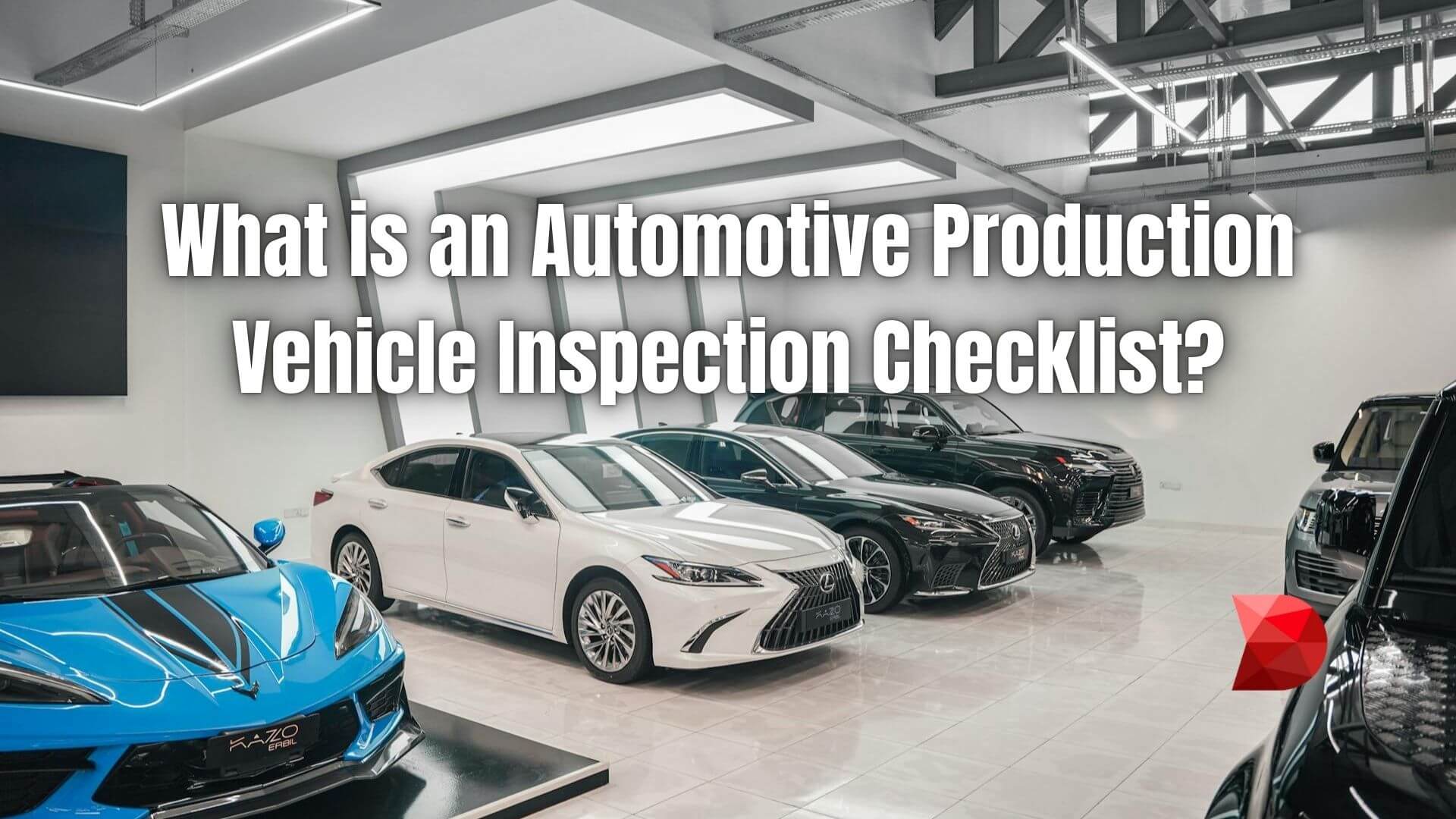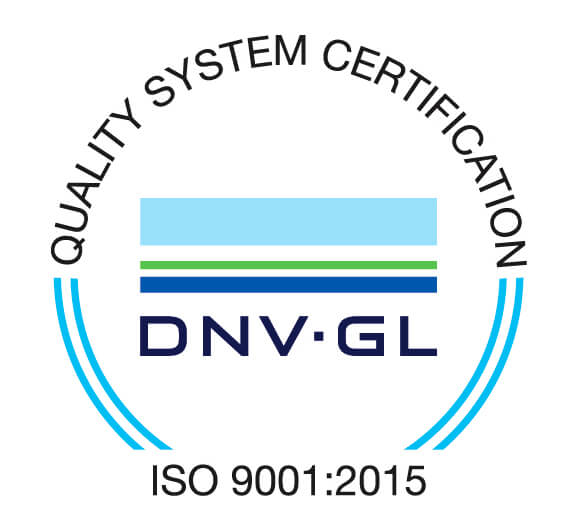Ensuring production vehicles are safe and reliable is essential for automotive production. A production vehicle inspection checklist helps to ensure that all safety aspects of production vehicles are taken into account, from hazards to diseases to ergonomics and more.
This article will provide a step-by-step guide on creating an automotive production vehicle inspection checklist that covers a wide range of topics to keep employees safe and help prevent any potential accidents or injuries on the job. By following these steps, you can create an easy-to-read, question-and-answer checklist explicitly designed for your production facility’s needs.
Table of Contents
ToggleWhat are Production Vehicles?
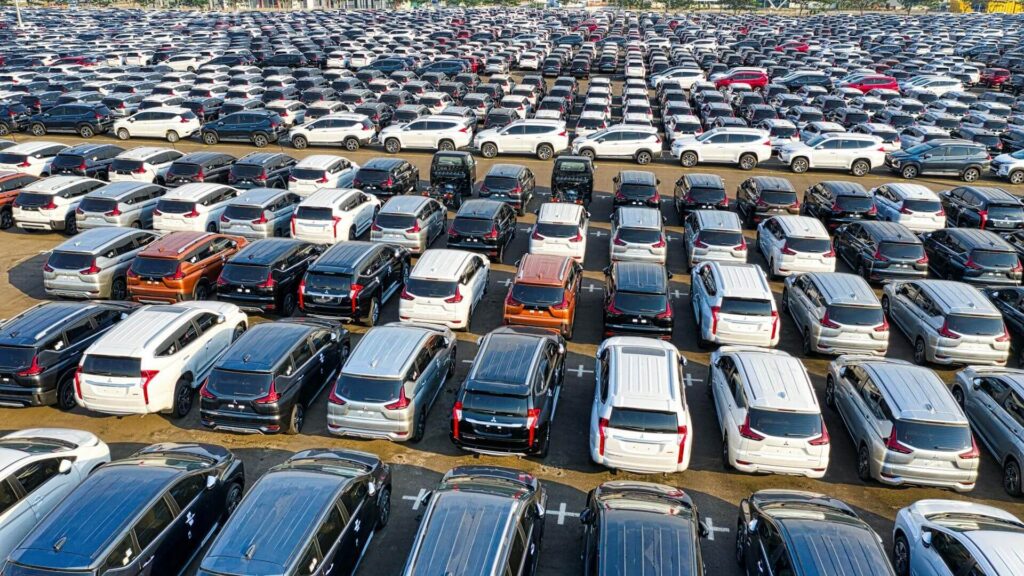
Production vehicles, or production cars, are mass-manufactured to the same specifications and made available for purchase to general consumers. Additionally, these automobiles must meet all legal requirements for public highway operation. Production vehicles are responsible for moving production materials and products from one place to another in production facilities.
What is an Automotive Production Vehicle Inspection?
An automotive production vehicle inspection is a process of inspecting production vehicles to ensure they are in proper working condition and ready for service. This type of inspection is conducted at production facilities and typically covers a wide range of topics, from identifying potential hazards to checking for diseases and ergonomic issues.
By conducting regular production vehicle inspections, production facilities can help reduce the likelihood of accidents or injuries occurring on the job. At the same time, production vehicles are inspected to ensure they meet all production requirements and standards.
What is an Automotive Production Vehicle Inspection Checklist?
An automotive production vehicle inspection checklist is an easy-to-read and comprehensive list of questions used to assess production vehicles’ health and safety. It covers various topics, from hazards to diseases to ergonomics and other production-related topics. The checklist should be tailored specifically to the production environment, with questions related to production processes, equipment, materials, and personnel.
By having an automotive production vehicle inspection checklist, production vehicles will be inspected regularly, and any issues can be quickly identified and addressed. This will ensure production vehicles are safe, healthy, and up to production standards.
What to Include in an Automotive Production Vehicle Inspection Checklist?
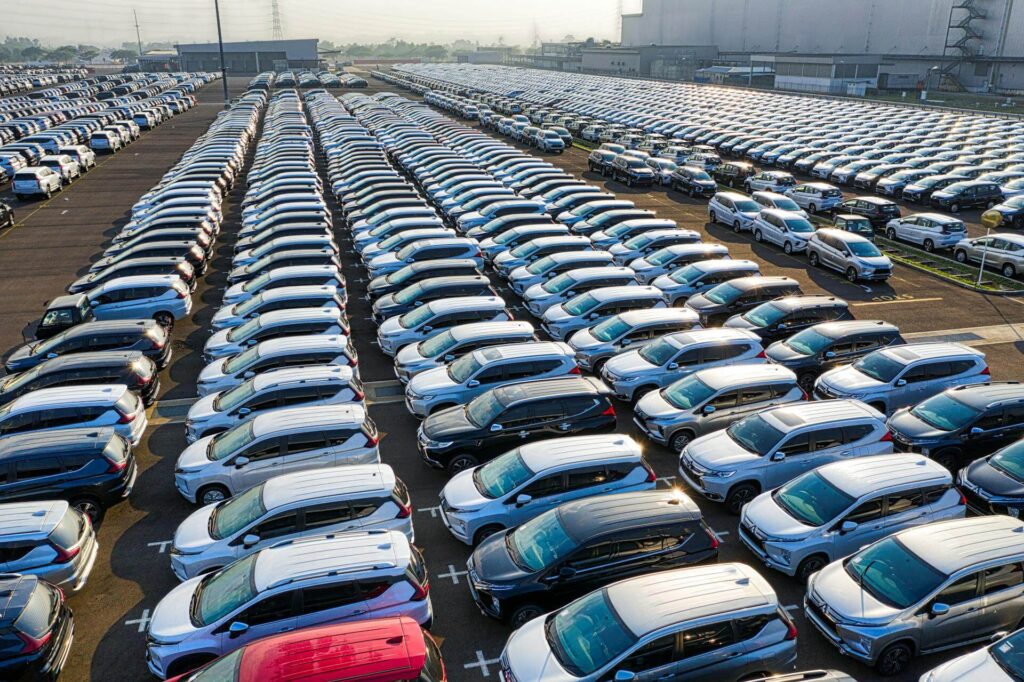
When creating an automotive production vehicle inspection checklist, it is important to include questions related to production processes, equipment, materials, and personnel. With that said, here are some key questions to have in the production vehicle inspection checklist:
Production Processes
For production processes, questions should focus on the following topics: safety protocols, production line production speed, and production downtime. Sample questions that fall into this category include:
- Are production safety protocols followed?
- Is production line production speed within the accepted limits?
- Is production downtime minimized?
- Are production line operators trained and knowledgeable?
Production Equipment
For production equipment, questions should focus on the following topics: maintenance, operation, and storage. Sample questions that fall into this category include:
- Is production equipment appropriately maintained?
- Is production equipment operated within the accepted limits?
- Are production tools stored in a safe, secure environment?
- Are production tools regularly inspected for functionality and safety?
Production Materials
For production materials, questions should focus on the following topics: availability, quantity, and quality. Sample questions that fall into this category include:
- Are production materials available in the right quantities?
- Are production materials of acceptable quality?
- Is production material handling done safely and properly?
- Are production materials stored in a safe, secure environment?
Production Personnel
For production personnel, questions should focus on the following topics: training and competency. Sample questions that fall into this category include:
- Are production personnel adequately trained?
- Do production personnel have the necessary competencies to do their job safely and properly?
- Are production personnel aware of production safety protocols?
- Are production personnel properly supervised and managed?
Expanded Inspection Areas
A comprehensive inspection of a vehicle involves a careful examination of its various components to ensure quality, safety, and performance. The following sections outline specific inspection areas that are critical for identifying defects, verifying functionality, and confirming adherence to industry standards.
Exterior Inspection
- Paint finish: Check for uniformity, color accuracy, orange peel effect, runs, sags, and other imperfections.
- Body panels: Inspect for alignment, gaps, scratches, dents, and damage.
- Lights: Verify functionality of headlights, taillights, brake lights, turn signals, reverse lights, and fog lights. Check for proper aim and brightness.
- Mirrors: Ensure mirrors are securely attached, free from cracks or distortions, and provide clear visibility.
- Windshield: Inspect for cracks, chips, scratches, and wiper blade condition.
- Tires: Check tire pressure, tread depth, wear patterns, and damage. Verify the condition of the spare tire and tools.
- Wheels: Inspect for damage, scratches, and proper alignment. Check lug nut tightness.
- Overall appearance: Assess the vehicle’s general condition, including cleanliness and any signs of previous damage or repairs.
Interior Inspection
- Seats: Check for tears, stains, damage, proper operation of adjustments, and headrest condition.
- Upholstery: Inspect for tears, stains, wrinkles, and overall cleanliness.
- Dashboard: Verify instrument cluster functionality, display clarity, and absence of cracks or damage.
- Controls: Test operation of all switches, buttons, and knobs, including climate control, audio system, and power windows.
- Instrumentation: Check gauges and warning lights for proper operation and accuracy.
- Audio system: Verify radio reception, CD player functionality, and speaker output.
- Climate control: Test heating and cooling systems for proper temperature control and airflow.
- Overall cleanliness: Assess the interior for cleanliness, including carpets, floor mats, and headliners.
Mechanical Inspection
- Engine: Check for leaks, unusual noises, smooth idle, and proper acceleration.
- Transmission: Verify smooth shifting, absence of clunks or grinds, and proper gear engagement.
- Brakes: Test brake pedal feel, stopping distance, and absence of pulsation or noise. Check brake pad and rotor wear.
- Steering: Verify steering wheel alignment, responsiveness, and absence of play or vibration.
- Suspension: Check for leaks, unusual noises, and proper handling.
- Exhaust system: Inspect for leaks, damage, and proper operation.
- Fluid levels: Verify engine oil, coolant, brake fluid, power steering fluid, and transmission fluid levels.
Electrical System Inspection
- Battery: Check battery condition, terminal connections, and charging system.
- Lights: Verify functionality of all exterior and interior lights, including headlights, taillights, brake lights, turn signals, hazard lights, interior lights, and dome lights.
- Turn signals: Test left and right turn signals for proper operation.
- Wipers: Check wiper blade condition, motor operation, and washer fluid level.
- Horn: Verify horn functionality.
- Power windows: Test all windows for smooth operation and proper sealing.
- Locks: Verify the operation of all door locks, trunk/hatch release, and ignition.
- Other electrical components: Test power outlets, sunroof operation, and any other electrical accessories.
Safety Features Inspection
- Airbags: Visually inspect airbag modules for damage and ensure proper deployment indicators.
- Seatbelts: Check for proper retraction, locking mechanisms, and anchor points. Verify seatbelt pretensioners and load limiters.
- Anti-lock brakes (ABS): Perform a brake test to verify ABS functionality.
- Electronic stability control (ESC): Verify ESC system operation through road testing.
- Other safety equipment: Inspect child seat anchors, head restraints, and emergency exit systems.
Functional Tests
- Lights: Test all exterior and interior lights, including headlights, taillights, brake lights, turn signals, hazard lights, interior lights, and dome lights.
- Wipers: Verify wiper motor operation, speed control, and washer fluid function.
- Horn: Test horn functionality.
- Windows: Check power window operation, manual window cranks, and window seals.
- Locks: Test all door locks, trunk/hatch release, and ignition.
- Climate control: Verify the operation of the heating and cooling system, including temperature control, fan speed, and airflow direction.
- Audio system: Test radio reception, CD player, and speaker output.
- Other systems: Test cruise control, power seats, mirrors, and any other vehicle functions.
Creating an automotive production vehicle inspection checklist is crucial to ensuring production vehicles are safe, healthy, and up to production standards. A comprehensive checklist will ensure production vehicles are regularly inspected and any issues can be quickly identified and addressed.
How to Create an Automotive Production Vehicle Inspection Checklist?
Creating an automotive production vehicle inspection checklist is essential to ensuring safety and compliance. This checklist ensures that production vehicles have been properly inspected and that all safety requirements have been met.
Here’s a step-by-step guide to creating an automotive production vehicle inspection checklist:
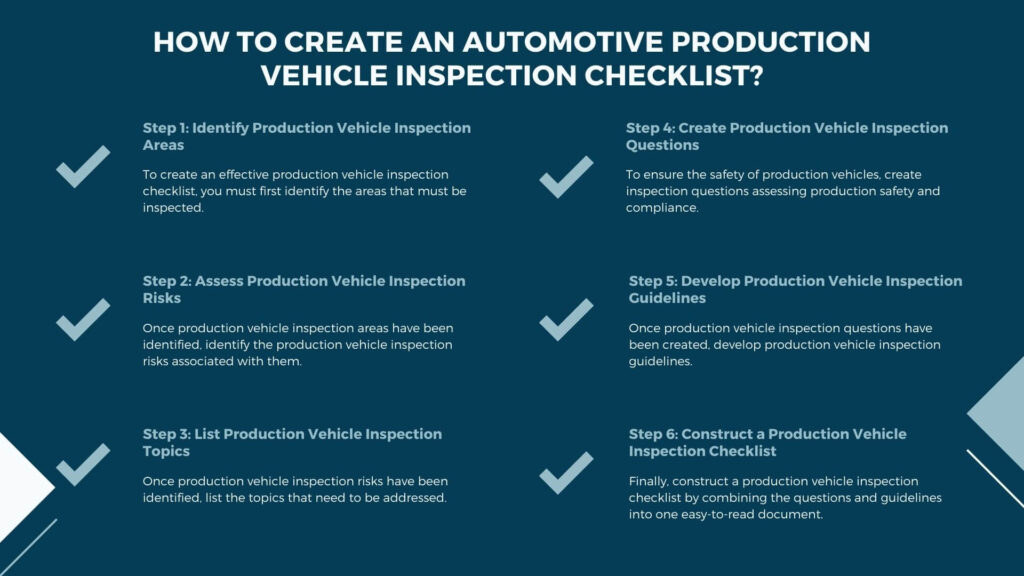
Step 1: Identify Production Vehicle Inspection Areas
To create an effective production vehicle inspection checklist, you must first identify the areas that must be inspected. This includes production vehicles, equipment, areas, and materials.
Step 2: Assess Production Vehicle Inspection Risks
Once production vehicle inspection areas have been identified, identify the production vehicle inspection risks associated with them. This could include hazards such as sharp edges, production materials that could cause allergic reactions and equipment that could cause injury or illness.
Step 3: List Production Vehicle Inspection Topics
Once production vehicle inspection risks have been identified, list the topics that need to be addressed. These could include production safety measures, production area design, equipment maintenance, production materials handling and storage, production vehicle ergonomics, and prevention of production diseases.
Step 4: Create Production Vehicle Inspection Questions
To ensure the safety of production vehicles, create inspection questions assessing production safety and compliance. If the questions are relevant to your production vehicle inspection areas, you can add as many as you need. Make sure the questions are easy to understand and answer.
Step 5: Develop Production Vehicle Inspection Guidelines
Once production vehicle inspection questions have been created, develop production vehicle inspection guidelines. These guidelines should include production safety measures, production area design, equipment maintenance, production materials handling and storage, production vehicle ergonomics, production disease prevention, and other production-related topics.
Step 6: Construct a Production Vehicle Inspection Checklist
Finally, construct a production vehicle inspection checklist by combining the questions and guidelines into one easy-to-read document. If needed, add production vehicle inspection tips and resources to the checklist.
By following this step-by-step guide to creating an automotive production vehicle inspection checklist, you can ensure production vehicles are safe and compliant. This will help you avoid production-related injuries and illnesses while ensuring production vehicles are functioning properly.
Industry Standards and Regulations in Automotive Production Vehicle Inspection
Adherence to industry standards and government regulations is crucial in ensuring the safety, quality, and environmental impact of automotive production vehicles. Standards bodies like ISO and AIAG, along with regulatory agencies such as NHTSA and EPA, establish benchmarks and requirements that manufacturers must meet.
A comprehensive production vehicle inspection checklist plays a crucial role in maintaining compliance. By systematically evaluating each vehicle against these standards, manufacturers can identify and rectify any deviations.
For instance, checking tire pressure and tread depth not only ensures vehicle safety but also aligns with fuel economy regulations set by the EPA. Similarly, inspecting emissions systems helps comply with air quality standards.
Moreover, adhering to industry standards, such as those outlined by AIAG, promotes consistency and efficiency in the inspection process. By following standardized checklists and procedures, manufacturers can streamline operations and reduce the risk of errors.
Incorporating industry standards and regulatory requirements into the inspection process is essential for protecting consumers, preserving the environment, and maintaining the automotive industry’s reputation.
Frequently Asked Questions (FAQs)
Q1: How often should a production vehicle inspection checklist be updated?
The frequency of checklist updates depends on several factors, including changes in vehicle technology, regulatory updates, and identified quality issues. Generally, a thorough review and update should be conducted annually, with minor adjustments made as needed to address emerging concerns.
Q2: What is the role of technology in production vehicle inspection checklists?
Technology plays an increasingly significant role in streamlining and improving the inspection process. Digital checklists, automated data collection systems, and image capture can enhance efficiency, accuracy, and traceability. Additionally, advanced analytics can be used to identify trends and potential issues based on inspection data.
Q3: How can I ensure that inspectors are consistent in applying the inspection checklist?
Consistent application of the checklist is crucial for maintaining quality standards. Implementing rigorous training programs, providing clear guidelines, and conducting regular audits can help ensure that inspectors are following the checklist accurately. Additionally, using standardized checklists and inspection forms can minimize variability.
Q4: What is the relationship between the production vehicle inspection checklist and warranty claims?
A well-executed inspection checklist can help reduce warranty claims by identifying and addressing potential issues before vehicles reach customers. By preventing defects from leaving the factory, manufacturers can improve customer satisfaction and reduce warranty costs.
Q5: How can I balance the need for thorough inspections with the need for efficiency?
Striking a balance between thoroughness and efficiency is essential for effective inspection processes. Prioritizing critical inspection points, utilizing technology to streamline data collection, and optimizing inspection workflows can help improve productivity without compromising quality.
Q6: What metrics can be used to measure the effectiveness of a production vehicle inspection checklist?
Key performance indicators (KPIs) can be used to assess the effectiveness of the inspection checklist. These metrics may include defect rates, rework rates, customer complaints, warranty claims, and first-pass yield. By tracking these metrics, manufacturers can identify areas for improvement and optimize the inspection process.
Conclusion
An automotive production vehicle inspection checklist is a vital tool for ensuring the quality, safety, and compliance of newly manufactured vehicles. By meticulously examining every aspect of a vehicle, from its exterior to its internal systems, manufacturers can identify and rectify defects, preventing subpar products from reaching consumers. Adherence to industry standards and regulations is essential in maintaining consumer trust and protecting the environment.
This article aims to provide a comprehensive overview of production vehicle inspection checklists, including their components, importance, and best practices. By understanding their critical role, automotive professionals can enhance their quality control processes and contribute to the overall success of their organizations.
To further optimize your inspection process, consider implementing advanced technologies, conducting regular training for inspectors, and continuously analyzing inspection data to identify trends and improvement opportunities. By prioritizing a robust inspection program, you can build a strong foundation for customer satisfaction and long-term business success.
Streamline Automotive Production Vehicle Inspections with DATAMYTE
DATAMYTE is a quality management platform with low-code capabilities. Our Digital Clipboard, in particular, is a low-code workflow automation software that features a workflow, checklist, and smart form builder. This tool lets you streamline automotive production vehicle inspections by easily creating and using an automotive production vehicle inspection checklist that ensures thorough and consistent quality checks.
DATAMYTE also lets you conduct layered process audits (LPA), a high-frequency evaluation of critical process steps, focusing on areas with the highest failure risk or non-compliance. Conducting LPA with DATAMYTE lets you effectively identify and correct potential defects before they become major quality issues.
With DATAMYTE, you have an all-in-one solution for efficiently managing and streamlining automotive production vehicle inspections. Book a demo now to learn more.

